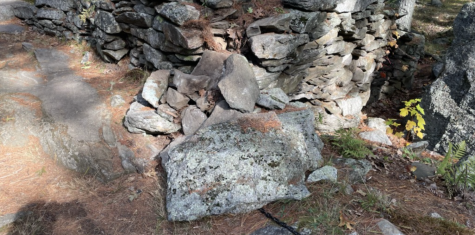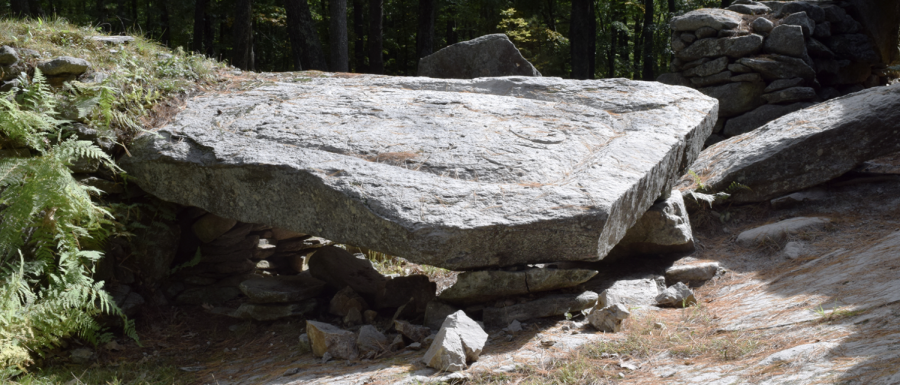It belongs in a museum, not an evidence locker
Malicious acts of vandalism at historic sites have gone unpunished by the criminal justice system, but justice must be served
November 17, 2022
The destruction of historic sites at the hands of vandals and criminals is a recurring problem for archeologists, property owners, and, I argue, for the human race itself. History is undoubtedly a factor in what makes us human, as we strive to learn not only about our past, but from our past. Yet in the present moment, crucial sites, from industrial mills to frontier homesteads to prehistoric ruins are being jeopardized by our own destructive tendencies.
People, either out of ignorance or pure lack of respect for the importance of our shared history, quite literally trample the last remaining traces of our ancestors, and thereby destroy our few precious links to the past. The good-intentioned of us will quite happily plow under the foundations of unique historic homes to make way for brand-new overpriced housing developments. The negligent will walk on historic walls or pick up one-of-a-kind artifacts to keep as a simple souvenir. The ill-intentioned may even paint or carve their messages of hate and self-aggrandizement into the last remaining monuments of our ancestors. And to what end? At best, we receive ugly, plastic houses on square lots with abhorrent mono-culture lawns. At worst, crucial archeological and historic evidence is defaced and lost forever, permanently severing our cultural blood-line.
This issue, however, has either been deemed unworthy of our public officials’ time, or our policymakers are merely uninformed; I sincerely hope the latter is the case. Vandals often go unpunished, as the criminal justice system fails to dedicate the time or resources to build cases against these destructive individuals. Two cases, which took place in the last few years in Salem, New Hampshire at America’s Stonehenge, stand out to me. The first involved a follower of QAnon, who carved an organizational slogan as well as his own name into the face of a stone slab which rests at the center of a unique prehistoric site. While I will not mention his name here, so as not to further glorify his selfish and hateful act, it should be known that this criminal showed no remorse in his actions, evidenced by the posts he made on Twitter depicting the aftermath of his deplorable handiwork. Not only did it take years for this vandal to be arrested, but the charges against him were later dismissed. No justice was served in this case, but the damage done is certainly felt by the owners and employees of America’s Stonehenge who had to repair the stone as much as possible, though it remains unclear how effective these repairs will be in the future. It is possible that the damage done by the vandal, which consisted of using a saw to carve several inches into the granite block, will lead to the artifact being further damaged if it is exposed to our harsh New England climate for much longer.
In the very same week that the charges were dismissed against the first vandal, a group of teenagers who had snuck onto the same property were seen by visitors climbing on the ancient stone walls, causing the corner of one wall to topple over. The damage, again, can never be fully repaired, as even a subtle change to a structure may render it useless to certain types of future archeological research. An entire portion of wall collapsing under the weight of a few vandals significantly alters the site, as any clues about the construction of the site that were hidden in the soil and sediment between the stones is now lost to the open air, and the layout of the stones themselves can not be replicated with complete accuracy. While the investigation is supposedly ongoing, I doubt that any more justice will come out of this case than the first one. Even photographic evidence of the perpetrators has yielded little headway with the responsible law enforcement agencies.
The damage caused by vandals at historic sites goes far deeper than the surface destruction they have caused, a fact it seems the criminal justice system does not take into account. There is, of course, the initial cost of repairing damages to artifacts which is much higher than the cost of repairing a typical structure or surface. Whereas washing off spray-paint, rebuilding a wall, or filling in a carving requires simple manual labor in a typical setting, the labor is far more intensive and specialized when dealing with artifacts. The process of repairing an artifact may risk causing even further damage to the artifact, so it is necessary for archaeologists and other material specialists to be involved in the reconstruction and/or cleaning process.
Going off of this , the damage done by vandals, as well as the reparation processes undertaken after the crime, risk invalidating an artifact’s utility to archeological research. No amount of expertise and labor will ever fully restore a damaged artifact, meaning the secrets it held about the past may never be fully understood. And, with the field of archeology constantly making technological advancements, it becomes imperative that artifacts are preserved for future research. Artifacts which have been tampered with may invalidate research, cause discrepancies in otherwise accurate findings, or cause gaps in the stories which archeology reveals to us. If we allow damage to continue to be inflicted on our material history, we may never fully understand human history as we desire.
Additionally, the damage in cases of severe vandalism can often not be fully repaired, meaning the damage will stay with that object forever. In the case of modern infrastructure, this is rarely taken into account, since the damaged structure can be replaced or the superficial damage merely ignored until it comes time for more extensive repairs. When it comes to artifacts, however, they can not simply be replaced. They are, by definition, one of a kind items which have an intrinsic value far superior to their material worth. It is not just the existence of an artifact which makes it special to us, but its existence in the context of its surroundings. These historic sites, no matter how old or well-known, are sacred to us for the simple fact that they are a part of human history. History can not be recreated, nor can it ever be replaced. When an artifact is damaged, it is an act of violence against the human spirit.
The fact of the matter is that policy makers and law enforcement officials have little to no respect for material and cultural history. These vandalism cases, like so many others which take place throughout the world, were handled no differently than if someone were to spray-paint their name on the side of an overpass. Officials seem to dedicate just as much time to petty cases of vandalism as they do to cases where priceless artifacts are destroyed and rendered nearly useless to future research. Courts apply the same penalties to vandals who desecrate sacred historic spaces as they do to teenagers who tag the side of a building.
Again, whether this utter lack of justice is a product of ignorance or contempt is unknown to me, but it must be stopped, and justice must be served. Law enforcement officials and prosecutors need to take these cases seriously, and appreciate the value of these historic sites beyond the surface physical damage caused by vandals when considering what charges to levy against these criminals. Similarly, policy makers must take into account the distinct cultural significance of our material history, and provide legislation which serves to protect these artifacts and impose more severe penalties for damaging them. Put simply, the criminal justice system needs to re-evaluate its priorities. Every day, we lose more and more history to time, let us not allow criminals, deviants, and degenerates to further contribute to that loss.
(While I am an employee of America’s Stonehenge Inc., this article only reflects my own personal views; I have written this opinion as a concerned student of criminal justice and lover of history).




